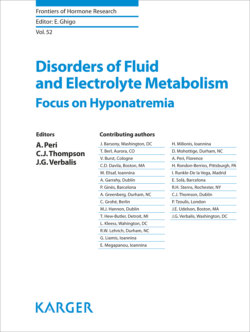Читать книгу Disorders of Fluid and Electrolyte Metabolism - Группа авторов - Страница 10
На сайте Литреса книга снята с продажи.
Early Descriptions of SIAD
ОглавлениеA critical advancement in our understanding of the pathogenesis of hyponatremia came in 1957 as a result of a series of clinical observations of 2 patients with the diagnosis of hyponatremia in the setting of bronchogenic carcinoma [6]. During the course of hospital admission, serum [Na+] fell significantly in both patients, to nadirs of 103 and 105 mEq/L, respectively. In the first case, it was found that ad libitum salt intake and slightly restricted fluid intake improved hyponatremia, maintaining near normal plasma sodium concentration. In the second case, however, hyponatremia persisted, despite the use of large amounts of salt, and was accompanied by a continuous loss of sodium in the urine. There were no signs of extracellular fluid sodium or fluid depletion, and both patients revealed normal kidney, thyroid and adrenal functions. The urine remained continuously hypertonic compared to the plasma as serum [Na+] fell. Transient elevations of serum [Na+] were found with large loads of hypertonic saline infusion followed by a significant diuresis of dilute urine. Fluid restriction in both subjects resulted in sodium retention and a return of serum [Na+] to near normal values. Conversely, restoration of free fluid intake worsened the “sodium-losing syndrome.”
The authors advanced the hypothesis that inappropriate urine concentration occurred in response to an antidiuretic hormone circulating in the plasma. Although they had no specific assay to measure plasma AVP concentrations, Schwartz et al. [6] were able to define the main principles of the diagnosis and treatment of this condition, such that their seminal paper remains the gold standard description of SIAD today. Interestingly, the fluid restriction that they used as a treatment for hyponatremia continued to be endorsed for years [7], and is still recommended by recent international guidelines as the first-line treatment for mildly symptomatic SIAD [8].
